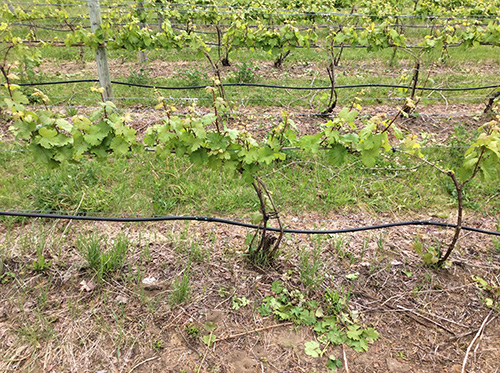Research vineyard updates on recovering Riesling and core cultivar planting
Updates at the northwest Michigan research vineyards on established Riesling and core cultivars, with progression pictures included.

The effects of the severe and consecutive advective freeze events, also known as the Polar Vortices, of the 2013-2014 and 2014-2015 winters have since been migrated through a combination of clever vineyard practices, replanting and relatively mild winters. However, the research vineyard at the Northwest Michigan Horticulture Research Center continues through its recovery process.
Established Riesling research vineyard
Before the significant vine damage caused by the cold events mentioned, this research vineyard was part of a multi-state variety trial to test the performance of about 20 or more cultivars that began in 2009. However, the project was not renewed and many of the grapevines were removed.
In year one (2015) following the most recent Polar Vortices, recovery of the research vineyard that is now comprised mainly of 9-year old Riesling grapevines was initiated by retraining all shoot growth from the trunk base. The shoots then hardened off into canes and were selected in spring of year two (2016) by training two canes bilaterally to the fruit wire with vertically shoot positioned shoots to establish trunks and fruitful cordons.
In year three (2017), recovery continued by retaining all shoots originating from the trunk base and orienting it into a fan shape with minimal management and no expectation or goal to produce and harvest quality fruit. As expected, these vines grew large by nearly filling the entire trellis space. The visual assessment of the large vine size was supported with 1-year-old pruning weights averaging about 2.55 pounds per vine.
In year four (2018), and in an effort to bring this vineyard into vegetative (shoots and leaves) and reproductive (fruit) balance, it was determined to adjust the pruning by retaining roughly double as many buds per vine as normal to spread the growth across a greater number of shoots. This bud number adjustment was accomplished by cane pruning these grapevines using four canes instead of the industry standard of two canes per vine. These Riesling grapevines are currently used in an applied research trial investigating the impact of various pruning, and leaf removal levels across multiple planting densities.
.jpg)
March 28, 2018. Pre-pruning.
.jpg)
March 21, 2018. Pre-Cordon removal.
.jpg)
March 28, 2018. Post-Cordon removal.
.jpg)
May 3, 2018. Post-Cordon training.
.jpg)
May 18, 2018. Post-Cordon training.
.jpg)
May 23, 2018. Post-bud break.
.jpg)
May 23, 2018. Closeup bud break.
.jpg)
June 5, 2018. 6-12 inch shoot growth. Pre-trunk shoot thinning.

June 5, 2018. 6-12 inch shoot. Post-trunk shoot thinning.
.jpg)
June 19, 2018. 1-3 foot shoot growth.
.jpg)
July 11, 2018. Post-leaf removal at around buck shot stage of development, before shoot hedging.
.jpg)
Aug. 8, 2018. Post-shoot hedging.
.jpg)
Sept. 4, 2018. Early veraison.
.jpg)
Sept. 4, 2018. Early veraison.
Core cultivar research vineyard
On May 30, 2018, 600 grapevines comprised of five cultivars—Cabernet franc, Chardonnay, Pinot blanc, Pinot gris and Pinot noir)—were planted at the Northwest Michigan Horticulture Research Center’s research vineyard with the assistance of a commercial vineyard management service and the newly hired viticulture research technician, Jasmine Hart.
Before planting, grapevines were root trimmed only when needed and then planted with the graft union about 3-4 inches above the soil line in a randomized complete block design with the aim to conduct statistical analysis to determine qualitative and quantitative protocols for specific cultivars.
Fortunately, the research vineyard is irrigated and received relatively cool conditions and a mix of cloudy and sunny days with adequate precipitation during the first two weeks of June to provide enough soil moisture to support these newly planted grapevines. These grapevines have been given foliar fungicide and fertilizers at a rate of once per 30 days starting six weeks after planting.
.jpg)
May 29, 2018. Plant preparation.
.jpg)
May 29, 2018. Plant preparation.
.jpg)
May 30, 2018. Soaking roots pre-planting.
.jpg)
May 18, 2018. Pre-planting.
.jpg)
June 5, 2018. Post-planting after bud break.
.jpg)
July 11, 2018. Post-planting.
.jpg)
Aug. 8, 2018. Post-planting.
.jpg)
Aug. 27, 2018. Post-planting.
.jpg)
Sept. 1, 2018. Post-planting.



 Print
Print Email
Email

